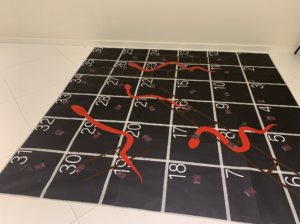 The Liar’s Grid is an analog game that incorporates aspects of other traditional games – Snakes and Ladders and Bluff. This game is played with a minimum of 2 players and a maximum if 4. The set up of the game includes a 6×6 numbered grid that has both snakes and ladders on certain squares of the grid .When a player lands on a grid with the head of a snake in it, the player has to move down to the square that has the tail of the snake in it. For the ladders, when a player lands on a box with the bottom of the ladder in it, the player moves to the square with the top of the ladder in it. The game also has cards randomly placed on each square of the grid. There is no card on the first and last squares of the grid. The sole objective of the game is for a player to get to the 36th square before another player does.
The Liar’s Grid is an analog game that incorporates aspects of other traditional games – Snakes and Ladders and Bluff. This game is played with a minimum of 2 players and a maximum if 4. The set up of the game includes a 6×6 numbered grid that has both snakes and ladders on certain squares of the grid .When a player lands on a grid with the head of a snake in it, the player has to move down to the square that has the tail of the snake in it. For the ladders, when a player lands on a box with the bottom of the ladder in it, the player moves to the square with the top of the ladder in it. The game also has cards randomly placed on each square of the grid. There is no card on the first and last squares of the grid. The sole objective of the game is for a player to get to the 36th square before another player does.

The way the game is played is that, before the players get onto the grid, each of them is given a starting card. The cards are numbered 1 – 6, indicating the number of steps to take. Subsequently, players pick up cards from each square on the grid they land on and that dictates how many steps they are required to move, However, players are allowed secretly to move fewer or more steps than the card displays in order to move faster, to avoid snakes or to reach ladders. After each move by a player, other players have the opportunity to challenge the other player’s movement to ascertain whether he/she was being honest and moving the number of steps on the card or was dishonest and moved a wrong number of steps. Should a player be found as being dishonest on a turn, he/she moves back the number of steps he/she was required to take. On the other hand, should a player be challenged whereas he/she was honest, the challenger moves back the number of steps that the card displays.

After a series of playtesting, a few modifications were made to the game. My team and I decided to place at least one snake and/or one ladder on each row of the grid in order to increase players’ incentives to cheat and by so doing, other players are more likely to challenge and thus making the game more fun and competitive. Also, we included a rule that stated that should any 2 players be in the same square, the second player to arrive in the square has to restart the game from the first square, This rule also increased the probability of cheating as well us prevented the game from becoming clumsy in the sense that each player could comfortably stand in a square and feel free.
The game was intended to reflect on the concepts of honesty and dishonesty. Often times in life people have goals which they try to attain. However, some use clean and morally upright ways while others use illegal ways to achieve it. This game, in a subtle manner, demonstrated the dilemma people go through – whether to cheat or not. The outcome of the game highlighted the reality that this world is indeed a dog-eat-dog world and the fact that people are willing to do everything within their means to succeed, whether right or wrong. This is seen in how certain players skillfully cheated their way to the end while other players who were trying to be honest got left behind.
Overall, The Liar’s Grid turned out as expected and was an awesome game to make and see people play and enjoy playing. It reflected clearly its deeper meaning and was altogether a success.
Link to pictures and videos: https://drive.google.com/open?id=1wUz18WrUYOpjakZrVCL8II0J7guwtzU5